Tit-for-tat Study guides, Class notes & Summaries
Looking for the best study guides, study notes and summaries about Tit-for-tat? On this page you'll find 30 study documents about Tit-for-tat.
Page 3 out of 30 results
Sort by
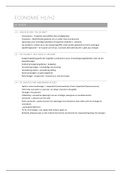
-
Samenvatting economie levensloop h1 en h2
- Summary • 2 pages • 2020
-
Available in package deal
-
- $3.30
- + learn more
Samenvatting economie LWEO Vwo 4 levensloop h1- kiezen (opofferingskosten, prisonersdilemma, nash-evenwicht, tit for tat strategie, bindende afspraken) en h2 -jeugd (inkomensverdeling, herverdeling, lorenzcurve, consumtie verschuiven). Ik heb een 8.0 gehaald voor deze toets door uit deze samenvatting te leren.
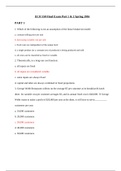
-
ECO 550 Final Exam Part 1 & 2 Spring 2016
- Exam (elaborations) • 16 pages • 2019
-
- $20.49
- + learn more
PART 1 1. Which of the following is not an assumption of the linear breakeven model: a. constant selling price per unit b. decreasing variable cost per unit c. fixed costs are independent of the output level d. a single product (or a constant mix of products) is being produced and sold e. all costs can be classified as fixed or variable 2. Theoretically, in a long-run cost function: a. all inputs are fixed b. all inputs are considered variable c. some inputs are always fixed d. capital and labor...
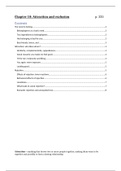
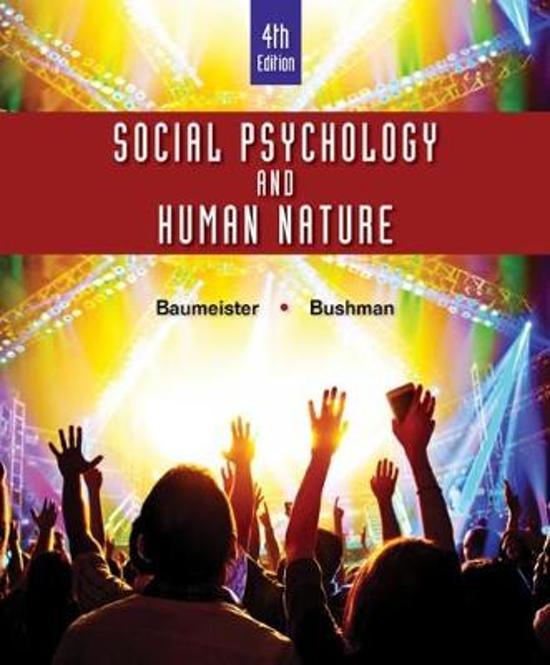
-
Summary chapter 10 - Attraction and exclusion (0HV30)
- Summary • 8 pages • 2019
-
Available in package deal
-
- $4.40
- + learn more
Summary of chapter 10 (Attraction and exclusion) of Social psychology and human nature by Baumeister and Bushman. The order of the book is followed, and the summary is based on the key words of the book. There is a table of contents, which may prove useful when searching for certain topics in the summary. The entire chapter is covered in this summary. Tip: you can also buy my 'Bundel' of 0HV30; this will save you some money in the end!
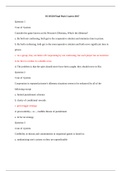
-
ECO550 Final Part 2 Latest 2017
- Exam (elaborations) • 11 pages • 2019
-
- $15.49
- + learn more
Question 1 4 out of 4 points Consider the game known as the Prisoner's Dilemma. What's the dilemma? a. By both not confessing, both get to the cooperative solution and minimize time in prison. b. By both confessing, both get to the noncooperative solution and both serve significant time in prison. c. As a group, they are better off cooperating by not confessing, but each player has an incentive to be first to confess in a double cross. d. The problem is that the spies should never have been caug...
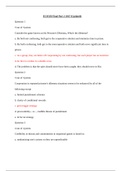
-
ECO550 Final Part 2 2017 (Updated)
- Exam (elaborations) • 11 pages • 2019
-
- $15.49
- + learn more
Question 1 4 out of 4 points Consider the game known as the Prisoner's Dilemma. What's the dilemma? a. By both not confessing, both get to the cooperative solution and minimize time in prison. b. By both confessing, both get to the noncooperative solution and both serve significant time in prison. c. As a group, they are better off cooperating by not confessing, but each player has an incentive to be first to confess in a double cross. d. The problem is that the spies should never have been caug...
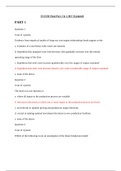
-
ECO550 Final Part 1 & 2 2017 (Updated)
- Exam (elaborations) • 21 pages • 2019
-
- $30.49
- + learn more
PART 1 Question 1 0 out of 4 points Evidence from empirical studies of long-run cost-output relationships lends support to the: a. existence of a non-linear cubic total cost function b. hypothesis that marginal costs first decrease, then gradually increase over the normal operating range of the firm c. hypothesis that total costs increase quadratically over the ranges of output examined d. hypothesis that total costs increase linearly over some considerable range of output examined e. none of th...
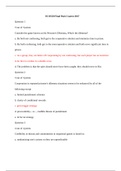
-
ECO550 Final Part 2 Latest 2017
- Exam (elaborations) • 11 pages • 2019
-
- $12.49
- + learn more
Question 1 4 out of 4 points Consider the game known as the Prisoner's Dilemma. What's the dilemma? a. By both not confessing, both get to the cooperative solution and minimize time in prison. b. By both confessing, both get to the noncooperative solution and both serve significant time in prison. c. As a group, they are better off cooperating by not confessing, but each player has an incentive to be first to confess in a double cross. d. The problem is that the spies should never have been caug...
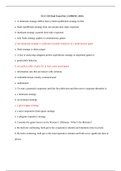
-
ECO 550 Final Exam Part 2 (SPRING 2016)
- Exam (elaborations) • 8 pages • 2019
-
- $10.49
- + learn more
1. A dominant strategy differs from a Nash equilibrium strategy in that a. Nash equilibrium strategy does not assume best reply responses b. dominant strategy assumes best reply responses c. only Nash strategy applies to simultaneous games d. one dominant strategy is sufficient to predict behavior in a multi-person game e. Nash strategy is often unique 2. A key to analyzing subgame perfect equilibrium strategy in sequential games is a. predictable behavior b. an explicit order of play for at lea...
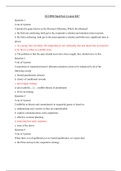
-
ECO550 Final Part 2 Latest 2017
- Exam (elaborations) • 8 pages • 2017
-
- $22.49
- + learn more
Question 1 4 out of 4 points Consider the game known as the Prisoner's Dilemma. What's the dilemma? a. By both not confessing, both get to the cooperative solution and minimize time in prison. b. By both confessing, both get to the noncooperative solution and both serve significant time in prison. c. As a group, they are better off cooperating by not confessing, but each player has an incentive to be first to confess in a double cross. d. The problem is that the spies should never have been ca...
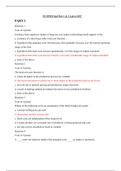
-
ECO550 Final Part 1 & 2 Latest 2017
- Exam (elaborations) • 16 pages • 2017
-
- $40.49
- + learn more
PART 1 Question 1 0 out of 4 points Evidence from empirical studies of long-run cost-output relationships lends support to the: a. existence of a non-linear cubic total cost function b. hypothesis that marginal costs first decrease, then gradually increase over the normal operating range of the firm c. hypothesis that total costs increase quadratically over the ranges of output examined d. hypothesis that total costs increase linearly over some considerable range of output examined e. none of th...

Do you wonder why so many students wear nice clothes, have money to spare and enjoy tons of free time? Well, they sell on Stuvia! Imagine your study notes being downloaded a dozen times for $15 each. Every. Single. Day. Discover all about earning on Stuvia


